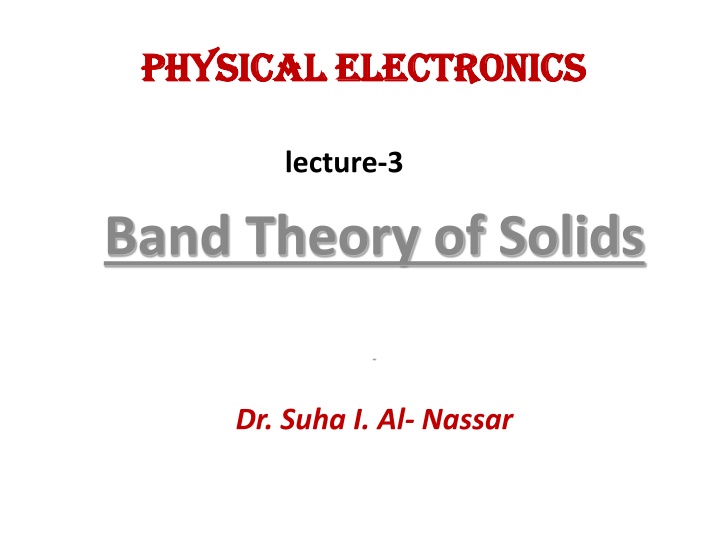
Band Theory of Solids in Electronics
Delve into the Band Theory of Solids in electronics, where electron energy levels are organized into bands, distinguishing between valence and conduction bands in insulators, semiconductors, and conductors. Explore the impact of temperature, doping, and energy gaps on semiconductor behavior, and learn about the three types of solids: amorphous, polycrystalline, and single crystals.
Uploaded on | 0 Views
Download Presentation

Please find below an Image/Link to download the presentation.
The content on the website is provided AS IS for your information and personal use only. It may not be sold, licensed, or shared on other websites without obtaining consent from the author. If you encounter any issues during the download, it is possible that the publisher has removed the file from their server.
You are allowed to download the files provided on this website for personal or commercial use, subject to the condition that they are used lawfully. All files are the property of their respective owners.
The content on the website is provided AS IS for your information and personal use only. It may not be sold, licensed, or shared on other websites without obtaining consent from the author.
E N D
Presentation Transcript
Physical Physical Electronics Electronics lecture-3 Band Theory of Solids Dr. Suha I. Al- Nassar
Band Theory of Solid in solids, permitted electron energy levels are organized as bands, The essential feature of theband theory is that the allowed energy states for electrons are nearly continuous over certain ranges, called energy bands. The valence band contains electrons that can be considered to be bound to the atom. In insulators and semiconductors the valence band is full. The conduction band is a region of permitted energy levels that is empty in insulators and semiconductors, but partially filled in conductors. Egit is a forbidden zone that forms an energy gap between the valence and conduction bands in insulators and semiconductors The band structures of insulators and semiconductors resemble each other qualitatively. Normally there exists in both insulators and semiconductors a filled energy band (referred to as the valence band) separated from the next higher band (referred to as the conduction band) by an energy gap. If this gap is at least several electron volts, the material is an insulator. It is too difficult for an applied field to overcome that large an energy gap, and thermal excitations lack the energy to promote sufficient numbers of electrons to the conduction band.
When the temperature is increased from T = 0, more and more atoms are found in excited states. The increased number of electrons in excited states explains the temperature dependence of the resistivity of semiconductors. Doping of semiconductors can significantly reduce the width of the energy gap. Only those electrons that have jumped from the valence band to the conduction band are available to participate in the conduction process in a semiconductor.
the differ between three types of solid according the differences of bands
TYPES OF SOLIDS Amorphous, polycrystalline, and single crystals are the three general types of solids. Each type is characterized by the size of an ordered region within the material as shown in below figure . a- a amorphous materials have an ordered region is a spatial volume in which atoms or molecules have a regular geometric arrangement or periodicity. Amorphous materials have order only within a few atomic or molecular dimensions. b- polycrystalline materials have a high degree of order over many atomic or molecular dimensions. These ordered regions, or single- crystal regions, vary in size and orientation with respect to one another. c- The single-crystal regions are called grains and are separated from one another by grain boundaries






















